Samsung Portable SSD T3 Review
by Ganesh T S on February 22, 2016 10:00 AM ESTSynthetic Benchmarks - ATTO and Crystal DiskMark
Samsung claims sequential read and write speeds of up to 450 MBps, and these are backed up by the ATTO benchmarks provided below. Unfortunately, these access traces are not very common in real-life scenarios.
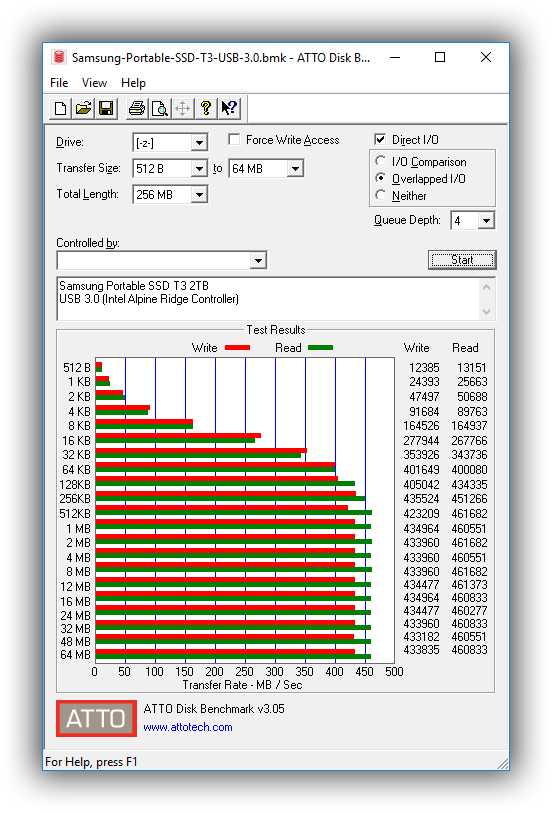
CrystalDiskMark, despite being a canned benchmark, provides a better estimate of the performance range with a selected set of numbers. As evident from the screenshot below, the performance can dip to as low as 20.68 MBps for random 4K reads. The presence of DRAM helps boost the performance quite a bit.
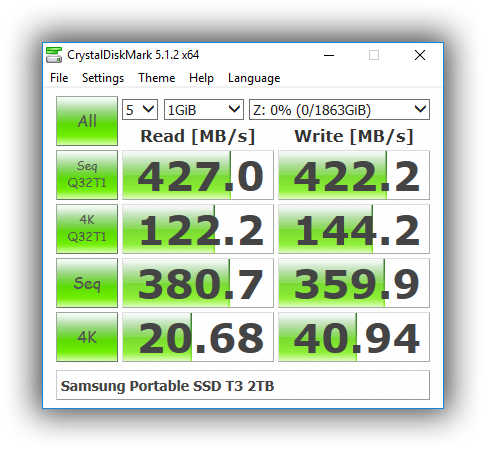
Benchmarks - robocopy and PCMark 8 Storage Bench
Our testing methodology for DAS units also takes into consideration the usual use-case for such devices. The most common usage scenario is transfer of large amounts of photos and videos to and from the unit. The minor usage scenario is importing files directly off the DAS into a multimedia editing program such as Adobe Photoshop.
In order to tackle the first use-case, we created three test folders with the following characteristics:
- Photos: 15.6 GB collection of 4320 photos (RAW as well as JPEGs) in 61 sub-folders
- Videos: 16.1 GB collection of 244 videos (MP4 as well as MOVs) in 6 sub-folders
- BR: 10.7 GB Blu-ray folder structure of the IDT Benchmark Blu-ray (the same that we use in our robocopy tests for NAS systems)






In almost all the cases, we find that the performance of the T3 slightly lags the performance of the T1. However, it is still faster than most other SSDs behind a SATA - USB bridge chip.
For the second use-case, we take advantage of PC Mark 8's storage bench. The storage workload involves games as well as multimedia editing applications. The command line version allows us to cherry-pick storage traces to run on a target drive. We chose the following traces.
- Adobe Photoshop (Light)
- Adobe Photoshop (Heavy)
- Adobe After Effects
- Adobe Illustrator
Usually, PC Mark 8 reports time to complete the trace, but the detailed log report has the read and write bandwidth figures which we present in our performance graphs. Note that the bandwidth number reported in the results don't involve idle time compression. Results might appear low, but that is part of the workload characteristic. Note that the same testbed is being used for all DAS units. Therefore, comparing the numbers for each trace should be possible across different DAS units. These benchmarks also point to the T3 being slightly behind T1 in performance.


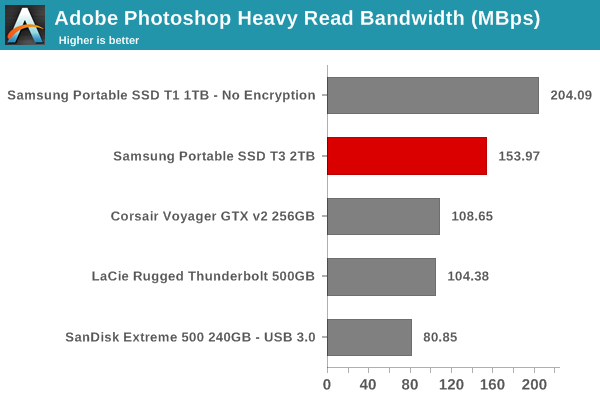


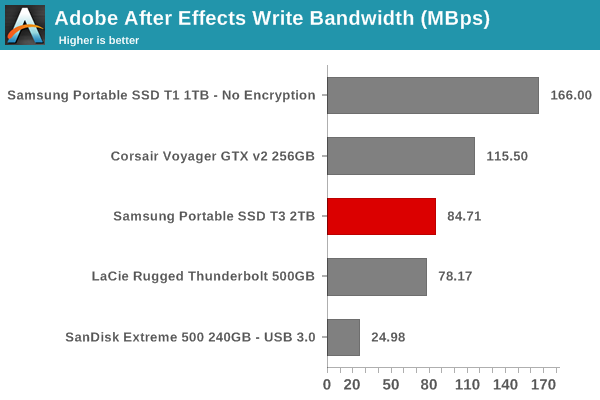
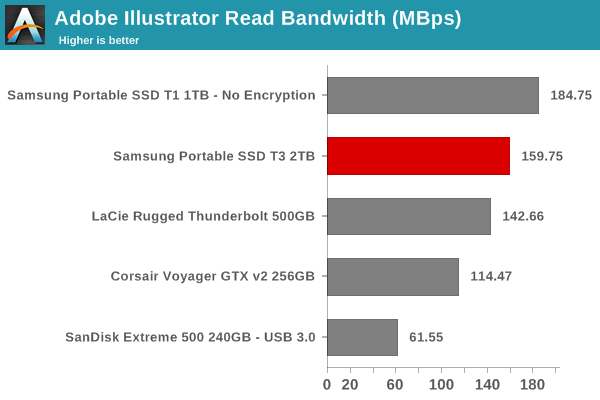











49 Comments
View All Comments
GU - Saturday, February 27, 2016 - link
Oh wait you are right! It was 2.73TB limit, sorry, my mistake.GU - Saturday, February 27, 2016 - link
And btw, you can create bigger partitions, but from linux only. I have 4 4TB drives and could not create partitions above the said limit on them from windows (maybe it can be done in windows above 7), it always created 2 partitions on the drives. And what is worse windows would not allow me to format them in any fat system. But what confuses me in the article is that it's "force" formatted. Does it mean that formatting the drive is blocked in some way?Heinrich D. Bag - Saturday, March 11, 2017 - link
There is freeware called GUIFORMAT that will allow larger drives to be formatted in FAT32. I had to do it for an AMAZON FIRE TV. Handy and free.zeeBomb - Monday, February 22, 2016 - link
Very nicekpb321 - Monday, February 22, 2016 - link
Android doesn't support exFAT in the default config because it has royalty requirements and they'd have to pay MS for that. Any phone that has a SDXC slot and supports 64gb+ sd cards should have exFAT support as that is what SDXC cards come pre-formatted as.Nintendo Maniac 64 - Monday, February 22, 2016 - link
Android uses the Linux kernel so you can use the likes of Ext4 (which it uses for its internal storage).Of course there's the issue where MS refuses to support anything other than FAT16, FAT32, NTFS, and exFAT...
tuxRoller - Tuesday, February 23, 2016 - link
There are ext4 fs drivers for Windows.Arbie - Monday, February 22, 2016 - link
If there's no info on TRIM, what should we expect? Does the drive drop to 1/3 its original speed, permanently, after you fill it up once? By 2016 I thought this was all solved.dano_spumoni - Wednesday, February 24, 2016 - link
Agreed, if i'm going to pay extra for a high performance external SSD I want it to behave similar to an internal SSD. Lack of TRIM support just goes to show the technology is not as mature as we hoped yet... Perhaps TRIM can be added through a software/firmware updates...zodiacfml - Monday, February 22, 2016 - link
Seems like 48 Layer V-NAND as they (Samsung) don't seem to care much with this product, only to sell the first few of the new dies.